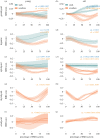The contractile patterns, anatomy and physiology of the hyoid musculature change longitudinally through infancy
- PMID: 33715426
- PMCID: PMC7944089
- DOI: 10.1098/rspb.2021.0052
The contractile patterns, anatomy and physiology of the hyoid musculature change longitudinally through infancy
Abstract
All mammalian infants suckle, a fundamentally different process than drinking in adults. Infant mammal oropharyngeal anatomy is also anteroposteriorly compressed and becomes more elongate postnatally. While suckling and drinking require different patterns of muscle use and kinematics, little insight exists into how the neuromotor and anatomical systems change through the time that infants suckle. We measured the orientation, activity and contractile patterns of five muscles active during infant feeding from early infancy until weaning using a pig model. Muscles not aligned with the long axis of the body became less mediolaterally orientated with age. However, the timing of activation and the contractile patterns of those muscles exhibited little change, although variation was larger in younger infants than older infants. At both ages, there were differences in contractile patterns within muscles active during both sucking and swallowing, as well as variation among muscles during swallowing. The changes in anatomy, coupled with less variation closer to weaning and little change in muscle firing and shortening patterns suggest that the neuromotor system may be optimized to transition to solid foods. The lesser consequences of aspiration during feeding on an all-liquid diet may not necessitate the evolution of variation in neuromotor function through infancy.
Keywords: EMG; feeding; mammal; ontogeny; swallowing.
Figures



References
-
- Smith KK. 1992. The evolution of the mammalian pharynx. Zool. J. Linn. Soc. 104, 313-349. (10.1111/j.1096-3642.1992.tb00926.x) - DOI
-
- Herring SW. 1985. Postnatal development of masticatory muscle function. In Vertebrate morphology (eds Duncker HR, Fleischer G), pp. 213-215. Stuttgart, Germany: Gustav Fischer Verlag.
Publication types
MeSH terms
Associated data
LinkOut - more resources
Full Text Sources
Other Literature Sources

